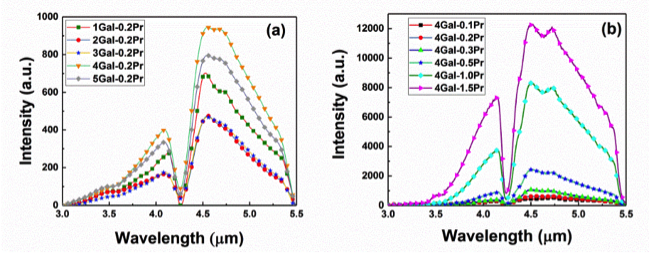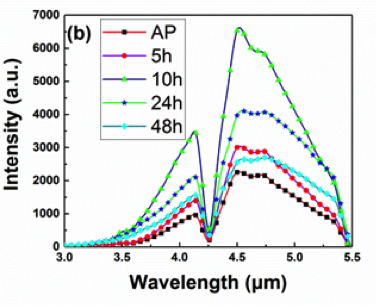Recently, Mingming Li (first author) and Yinsheng Xu, associate researcher (corresponding author) have obtained the latest research progress in the mid-infrared emission characteristics of Pr3+-doped Ge-Sb-Se-Ga-I chalcogenide glasses in the laboratory. The title of the thesis is: Mid-infrared Emission Properties of Pr3+-doped Ge–Sb–Se–Ga–I Chalcogenide Glasses. The relevant research work is piblished in Optical Materials Express Vol. 8, Issue 4, pp. 992-1000 (2018). (DOI: 10.1364/OME.8.000992).
Mid-infrared emission materials have many potential applications in the fields of medicine, environment pollution monitoring, biology, agricliture and seurity. The mid-infrared(MIR), which operate in the range of wavelengths spanning from 3 μm to 5 μm, correspondes to the characteristic molecular absorption and vibrational energy bands of most gas, liquid, and solid phases, and is located within the atmospheric transmission window. The characteristic absorption of the target molecule enables people to detect specific gases and is very useful for detecting harmful gases in the air or chemical reaction gases in the production process. The biological tissue also has a typical fingerprint spectrum in the mid-infrared spectral range, and can be biologically detected and modified with a mid-infrared light source. In this work, Pr3+-doped Ge22Sb8Se70-2x(GaI)x (x = 1-5) chalcogenide glasses were used to study the mid-infrared spectral properties. And glass structures ,optical, thermal and luminescent properties were studied. the emission intensity at 3–5.5 μm increased with addition of GaI as shown in the Fig. 1. The maximum emission was obtained in the sample containing mostly GaI contents. The strongest fluorescence intensity was achieved at 4 mol% GaI. 0.2-1.5 mol% Pr 3+ doped Ge-Sb-Se-Ga-I glass exhibited intense photoluminescence in the wavelength range of 3.5-5.5 μm as shown in Figure 1 under 1.55 μm LD excitation. The strongest fluorescence intensity was obtained. By Raman spectroscopy, it was found that the phonon energy of the glass was decreased as the concentration of GaI increased. And testing of GeSe 2 and Sb 2 Se 3 nanocrystals in glass ceramics was observed by heat treating the precursor glass at a temperature above its glass transition temperature (Tg + 30°C) for different durations. After heat treatment, the 3.5-5.5 μm emission intensity of the glass is increased and reached a maximum after 10 hours of heat treatment.

Figure 2. MIR emission spectra of Pr3+-doped samples under 1.55 μm nm laser excitation (a) with increase in GaI concentration and (b) with increase of Pr3+ ion concentration

Figure 4. Normalized Raman spectra of Ge22Sb8Se70−2x(GaI)x(x=1, 2,3,4,5)–0.2Pr glass

Figure 6 Infrared emission spectra of Ge22Sb8Se62(GaI)4–0.5Pr base glass and glass ceramics obtained by heat treatments at 312 °C for different durations under 1550 nm laser excitation, respectively.
Paper link: https://www.osapublishing.org/ome/abstract.cfm?uri=ome-8-4-992


